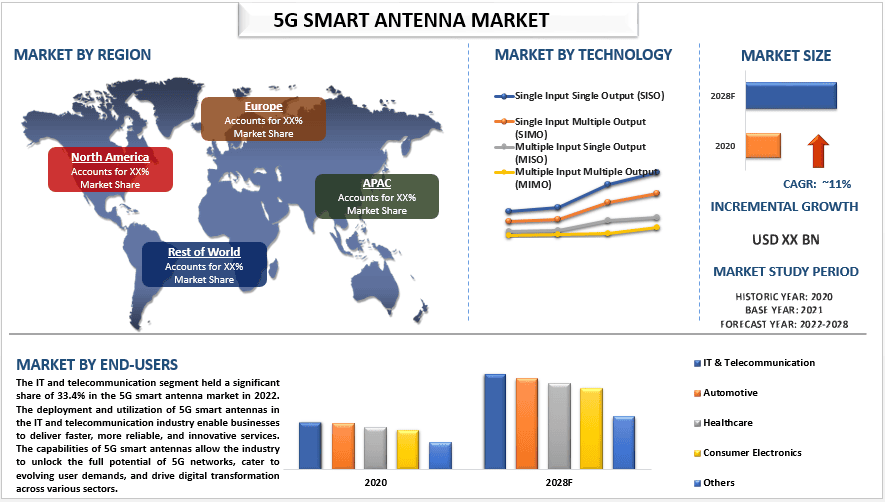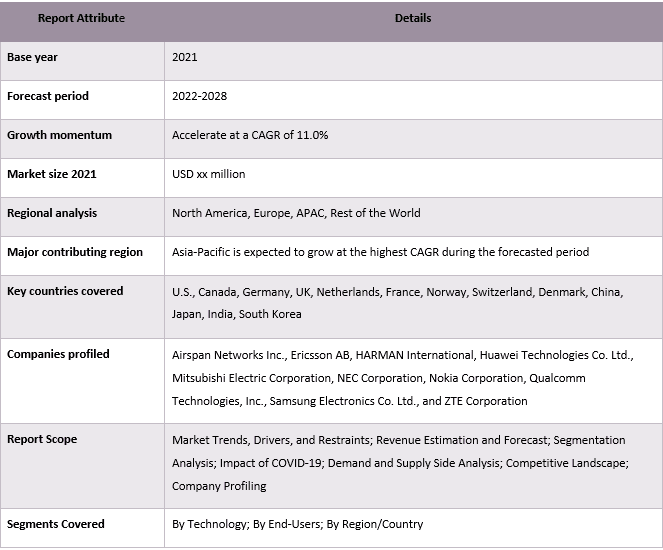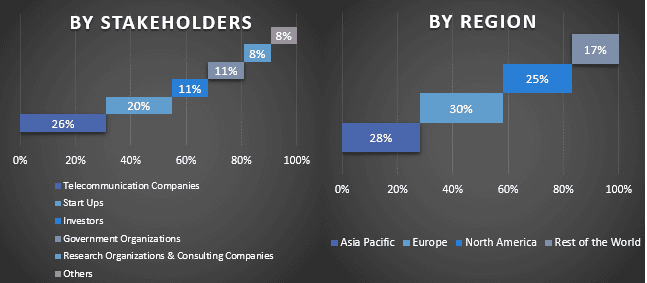- Home
- About Us
- Industry
- Services
- Reading
- Contact Us
5G Smart Antenna Market: Current Analysis and Forecast (2022-2028)
Emphasis on Technology (Single Input Single Output (SISO), Single Input Multiple Output (SIMO), Multiple Input Single Output (MISO), and Multiple Input Multiple Output (MIMO)); End-Users (IT & Telecom, Automotive, Healthcare, Consumer Electronics, and Others) Region/Country.

The 5G smart antenna market is expected to grow at a strong CAGR of around 11% during the forecast period. A 5G smart antenna is a type of antenna that is designed to support the fifth generation (5G) of mobile networks. It is a key component of 5G technology, as it enables faster data transfer rates, increased network capacity, and enhanced reliability. 5G smart antennas are designed to support a wide range of applications, including enhanced mobile broadband, massive machine-type communications, and ultra-reliable low-latency communications. They are capable of supporting a large number of connected devices, including smartphones, tablets, and other IoT devices. The implementation of 5G smart antennas is expected to bring new opportunities for the growth of various industries, including healthcare, manufacturing, and transportation. For example, 5G smart antennas can support real-time monitoring and control of industrial processes, enabling more efficient and cost-effective operations. In addition, 5G smart antennas can support new applications and services, such as augmented and virtual reality, autonomous vehicles, and remote surgery. These applications require high-speed data transfer rates, low latency, and increased network capacity, which can be provided by 5G smart antennas. Overall, 5G smart antennas are an important component of 5G technology, and they have the potential to revolutionize various industries by improving connectivity, increasing network capacity, and enabling new applications and services.
Insights Presented in the Report
“Amongst technology, the MIMO segment held a dominating share of the market in 2021”
On the basis of technology, the market is segmented into Single Input Single Output (SISO), Single Input Multiple Output (SIMO), Multiple Input Single Output (MISO), and Multiple Input Multiple Output (MIMO). The MIMO (Multiple Input Multiple Output) technology segment held the largest share of 39.1% in the 5G smart antenna market in 2022, and it is expected to maintain its leading position during the forecast period. MIMO technology plays an important role in 5G smart antennas, enabling higher data rates, improved coverage, enhanced spectral efficiency, and better overall network performance. In 5G smart antennas, MIMO technology utilizes multiple antennas at both the transmitter and receiver sides to enhance the signal-to-noise ratio, reduce interference, and increase the capacity of the network. The use of MIMO technology in 5G smart antennas enables higher data rates, improved coverage, and enhanced spectral efficiency, which is critical for supporting the demanding requirements of 5G networks and their applications.
“Amongst end-users, the IT and telecommunication segment held a dominating share of the market in 2021”
Based on end-users, the market is segmented into it & telecom, automotive, healthcare, consumer electronics, and others. The IT and telecommunication segment held a significant share of 33.4% in the 5G smart antenna market in 2022, and it is expected to maintain this status quo and expand at a growth rate of 11.8% during the forecast period. The deployment and utilization of 5G smart antennas in the IT and telecommunication industry enable businesses to deliver faster, more reliable, and innovative services. The capabilities of 5G smart antennas allow the industry to unlock the full potential of 5G networks, cater to evolving user demands, and drive digital transformation across various sectors.
“Asia Pacific dominated the 5G smart antenna market in 2021.”
Asia Pacific dominated the global 5G smart antenna market in 2022, with a share of 40.1%. The region’s growth is driven by factors such as the increasing rate of mobile internet penetration and the rise in the population accessing the internet through smartphones and mobile devices. Further, the increasing number of connected devices and the rising popularity of smart devices are also expected to drive the growth of the 5G smart antenna market in the Asia Pacific region. The growing adoption of IoT and the increasing number of smartphone users are also expected to contribute to the growth of the market.
5G Smart Antenna Market Report Coverage

Reasons to buy this report:
- The study includes market sizing and forecasting analysis validated by authenticated key industry experts.
- The report presents a quick review of overall industry performance at one glance.
- The report covers an in-depth analysis of prominent industry peers with a primary focus on key business financials, product portfolios, expansion strategies, and recent developments.
- Detailed examination of drivers, restraints, key trends, and opportunities prevailing in the industry.
- The study comprehensively covers the market across different segments.
- Deep dive regional level analysis of the industry.
Customization Options:
The global 5G smart antenna market can further be customized as per the requirement or any other market segment. Besides this, UMI understands that you may have your own business needs, hence feel free to connect with us to get a report that completely suits your requirements.
Table of Content
Research Methodology for the 5G Smart Antenna Market Analysis (2022-2028)
Analyzing the historical market, estimating the current market, and forecasting the future market of the global 5G smart antenna market were the three major steps undertaken to create and analyze the adoption of 5G smart antenna in major regions globally. Exhaustive secondary research was conducted to collect the historical market numbers and estimate the current market size. Secondly, to validate these insights, numerous findings and assumptions were taken into consideration. Moreover, exhaustive primary interviews were also conducted, with industry experts across the value chain of the global 5G smart antenna market. Post assumption and validation of market numbers through primary interviews, we employed a top-down/bottom-up approach to forecasting the complete market size. Thereafter, market breakdown and data triangulation methods were adopted to estimate and analyze the market size of segments and sub-segments of the industry pertains to. Detailed methodology is explained below:
Analysis of Historical Market Size
Step 1: In-Depth Study of Secondary Sources:
Detail secondary study was conducted to obtain the historical market size of the 5G smart antenna market through company internal sources such as annual reports & financial statements, performance presentations, press releases, etc., and external sources including journals, news & articles, government publications, competitor publications, sector reports, third-party database, and other credible publications.
Step 2: Market Segmentation:
After obtaining the historical market size of the 5G smart antenna market, we conducted a detailed secondary analysis to gather historical market insights and share for different segments & sub-segments for major regions. Major segments are included in the report as technology and end-users. Further country-level analyses were conducted to evaluate the overall adoption of testing models in that region.
Step 3: Factor Analysis:
After acquiring the historical market size of different segments and sub-segments, we conducted a detailed factor analysis to estimate the current market size of the 5G smart antenna market. Further, we conducted factor analysis using dependent and independent variables such as technology and end-users of the 5G smart antenna market. A thorough analysis was conducted for demand and supply-side scenarios considering top partnerships, mergers and acquisitions, business expansion, and product launches in the 5G smart antenna market sector across the globe.
Current Market Size Estimate & Forecast
Current Market Sizing: Based on actionable insights from the above 3 steps, we arrived at the current market size, key players in the global 5G smart antenna market, and market shares of the segments. All the required percentage shares split, and market breakdowns were determined using the above-mentioned secondary approach and were verified through primary interviews.
Estimation & Forecasting: For market estimation and forecast, weights were assigned to different factors including drivers & trends, restraints, and opportunities available for the stakeholders. After analyzing these factors, relevant forecasting techniques i.e., the top-down/bottom-up approach were applied to arrive at the market forecast for 2028 for different segments and sub-segments across the major markets globally. The research methodology adopted to estimate the market size encompasses:
- The industry’s market size, in terms of revenue (USD) and the adoption rate of the 5G smart antenna market across the major markets domestically
- All percentage shares, splits, and breakdowns of market segments and sub-segments
- Key players in the global 5G smart antenna market in terms of products offered. Also, the growth strategies adopted by these players to compete in the fast-growing market
Market Size and Share Validation
Primary Research: In-depth interviews were conducted with the Key Opinion Leaders (KOLs) including Top Level Executives (CXO/VPs, Sales Head, Marketing Head, Operational Head, Regional Head, Country Head, etc.) across major regions. Primary research findings were then summarized, and statistical analysis was performed to prove the stated hypothesis. Inputs from primary research were consolidated with secondary findings, hence turning information into actionable insights.
Split of Primary Participants in Different Regions

Market Engineering
The data triangulation technique was employed to complete the overall market estimation and to arrive at precise statistical numbers for each segment and sub-segment of the global 5G smart antenna market. data was split into several segments & sub-segments post studying various parameters and trends in the areas of the technology and end-users in the global 5G smart antenna market.
The main objective of the Global 5G Smart Antenna Market Study
The current & future market trends of the global 5G smart antenna market were pinpointed in the study. Investors can gain strategic insights to base their discretion for investments on the qualitative and quantitative analysis performed in the study. Current and future market trends determined the overall attractiveness of the market at a regional level, providing a platform for the industrial participant to exploit the untapped market to benefit from a first-mover advantage. Other quantitative goals of the studies include:
- Analyze the current and forecast market size of the 5G smart antenna market in terms of value (USD). Also, analyze the current and forecast market size of different segments and sub-segments
- Segments in the study include areas of the technology and end-users
- Define and analysis of the regulatory framework for the 5G smart antenna
- Analyze the value chain involved with the presence of various intermediaries, along with analyzing customer and competitor behaviors of the industry
- Analyze the current and forecast market size of the 5G smart antenna market for the major region.
- Major countries of regions studied in the report include Asia Pacific, Europe, North America, and the Rest of the World
- Company profiles of the 5G smart antenna market and the growth strategies adopted by the market players to sustain in the fast-growing market
- Deep dive regional level analysis of the industry
Related Reports
Customers who bought this item also bought










